高中必修一英语语法
(完整版)高中英语语法(人教版)
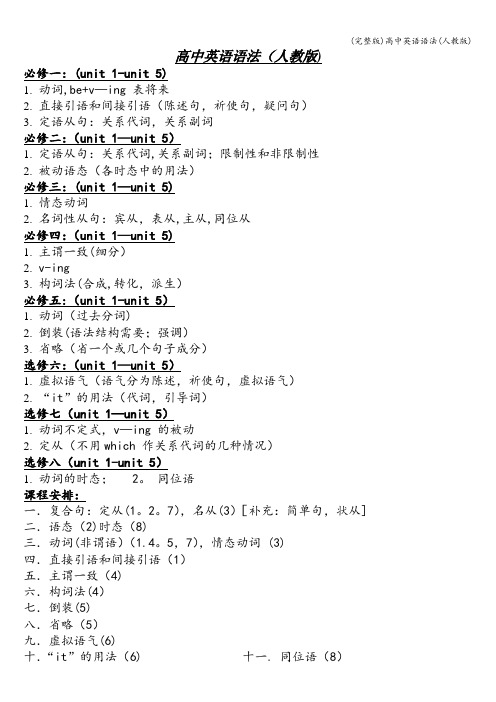
(完整版)高中英语语法(人教版)
高中英语语法(人教版)
必修一:(unit 1-unit 5)
1.动词,be+v—ing 表将来
2.直接引语和间接引语(陈述句,祈使句,疑问句)
3.定语从句:关系代词,关系副词
必修二:(unit 1—unit 5)
1.定语从句:关系代词,关系副词;限制性和非限制性
2.被动语态(各时态中的用法)
必修三:(unit 1—unit 5)
1.情态动词
2.名词性从句:宾从,表从,主从,同位从
必修四:(unit 1—unit 5)
1.主谓一致(细分)
2.v-ing
3.构词法(合成,转化,派生)
必修五:(unit 1-unit 5)
1.动词(过去分词)
2.倒装(语法结构需要;强调)
3.省略(省一个或几个句子成分)
选修六:(unit 1—unit 5)
1.虚拟语气(语气分为陈述,祈使句,虚拟语气)
2.“it”的用法(代词,引导词)
选修七(unit 1—unit 5)
1.动词不定式,v—ing 的被动
2.定从(不用which 作关系代词的几种情况)
选修八(unit 1-unit 5)
1.动词的时态; 2。
同位语
课程安排:
一.复合句:定从(1。
2。
7),名从(3)[补充:简单句,状从]
二.语态(2)时态(8)
三.动词(非谓语)(1.4。
5,7),情态动词 (3)
四.直接引语和间接引语(1)
五.主谓一致(4)
六.构词法(4)
七.倒装(5)
八.省略(5)
九.虚拟语气(6)
十.“it”的用法(6) 十一. 同位语(8)。
高一英语必修一语法归纳
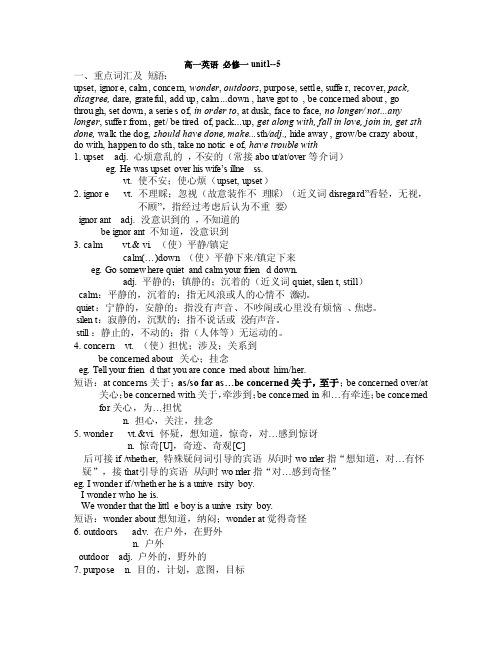
高一英语必修一 unit1--5一、重点词汇及短语:upset, ignore, calm, concer n, wonder, outdoo rs, purpos e, settle, suffer, recove r, pack, disagr ee, dare, gratef ul, add up, calm...down , have got to , be concer ned about, gothroug h, set down, a series of, in orderto, at dusk, face to face, no longer/ not...any longer, suffer from, get/ be tiredof, pack...up, get alongwith, fall in love, join in, get sth done, walk the dog, should have done, make...sth/adj., hide away, grow/be crazyabout, do with, happen to do sth, take no notice of, have troubl e with1. upsetadj. 心烦意乱的,不安的(常接abou t/at/over等介词)eg. He was upsetoverhiswife‘sillnes s.vt. 使不安;使心烦(upset, upset)2. ignore vt. 不理睬;忽视(故意装作不理睬)(近义词disregar d‖看轻,无视,不顾‖,指经过考虑后认为不重要)ignora nt adj. 没意识到的,不知道的be ignora nt 不知道,没意识到3. calm vt.& vi. (使)平静/镇定calm(…)down(使)平静下来/镇定下来eg. Go somewh ere quietand calm your friend down.adj. 平静的;镇静的;沉着的(近义词quiet, silent, still)calm:平静的,沉着的;指无风浪或人的心情不激动。
英语高一必修一语法
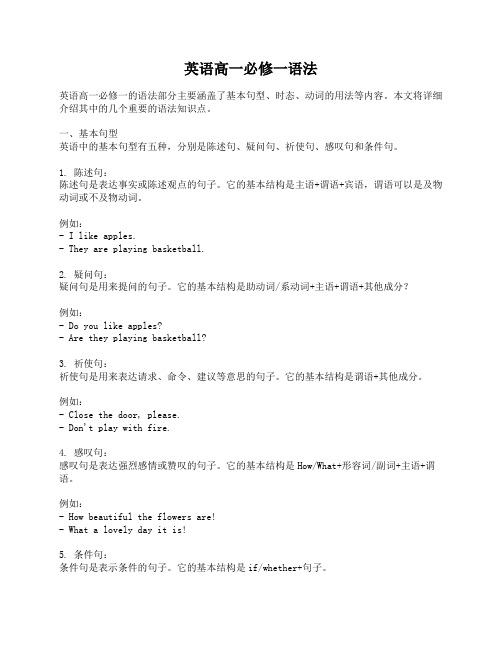
英语高一必修一语法英语高一必修一的语法部分主要涵盖了基本句型、时态、动词的用法等内容。
本文将详细介绍其中的几个重要的语法知识点。
一、基本句型英语中的基本句型有五种,分别是陈述句、疑问句、祈使句、感叹句和条件句。
1. 陈述句:陈述句是表达事实或陈述观点的句子。
它的基本结构是主语+谓语+宾语,谓语可以是及物动词或不及物动词。
例如:- I like apples.- They are playing basketball.2. 疑问句:疑问句是用来提问的句子。
它的基本结构是助动词/系动词+主语+谓语+其他成分?例如:- Do you like apples?- Are they playing basketball?3. 祈使句:祈使句是用来表达请求、命令、建议等意思的句子。
它的基本结构是谓语+其他成分。
例如:- Close the door, please.- Don't play with fire.4. 感叹句:感叹句是表达强烈感情或赞叹的句子。
它的基本结构是How/What+形容词/副词+主语+谓语。
例如:- How beautiful the flowers are!- What a lovely day it is!5. 条件句:条件句是表示条件的句子。
它的基本结构是if/whether+句子。
例如:- If it rains tomorrow, we will stay at home.- Whether she comes or not, I will go to the party.二、时态在英语中,时态用于表示动作发生的时间。
高一必修一中涵盖了一般现在时、一般过去时、一般将来时等几个基本时态。
1. 一般现在时:一般现在时用于表示经常性的动作、习惯、真理、科学事实等。
它的基本结构是主语+谓语。
例如:- She goes to school every day.- Water boils at 100 degrees Celsius.2. 一般过去时:一般过去时用于表示过去发生的动作或状态。
高一英语必修一语法知识总结

高一英语必修一语法知识总结不要觉得英语很难,它不难,只要认真去学,肯定能学好。
今天小编在这给大家整理了高一英语必修一语法知识总结,接下来随着小编一起来看看吧!一般现在时、现在进行时、-ing 形容词和-ed 形容词的用法考点 1:一般现在时的用法1.表示经常性、习惯性的动作。
句中常出现 often, usually, sometimes, always, every day 等状语。
He goes to school at seven o'clock every day. 他每天七点去上学。
She always takes a walk in the evening. 她常在晚间散步。
We always care about and help each other. 我们总是互相关心、互相帮助。
2.表示普遍的真理、科学事实,也用在格言中。
Light travels faster than sound. 光比声音传播得快。
Actions speak louder than words. 行动比言语更为响亮。
3.在时间状语从句和条件状语从句中,通常用一般现在时代替一般将来时。
When I graduate, I'll go back to the countryside. 我毕业后将回农村。
They won't come to see us if it rains next Sunday. 如果下周日下雨,他们就不会来看我们了。
4.表示按规定或时刻表将要发生的动作,仅限于少数动词,如 begin, leave, go, arrive, start 等。
The meeting begins at eight. 会议八点开始。
The train starts at nine in the morning. 火车早上九点出发。
5.表示主语的特征、性格或说话时的感觉、状态。
This job calls for great patience. 这项工作需要极大的耐心。
高一英语必修一语法知识点总结

高一英语必修一语法知识点总结高一英语必修一语法知识点1高一英语必修一知识点总结:Unit11.be good to对……友好be good for对……有益;be bad to…/be bad for…2.add up加起来增加add up to合计,总计add…to把……加到……3.not…until/till意思是“直到…才”4.get sth/sb done使……完成/使某人被……5.calm down平静下来6.be concerned about关心,关注7.当while,when,before,after 等引导的时间状语从句中的主语与主句的主语一致时,可将从句中的主语和be动词省去。
While walking the dog,you were careless and it got loose.8.cheat in the exam考试9.go through经历;度过;获准,通过10.hide away躲藏;隐藏11.set down写下,记下12.I wonder if…我不知道是不是…12.on purpose故意13.sth happen to sb某人发生某事sb happen to do sth某人碰巧做某事it so happened that……正巧碰巧14.It is the first(second…)that…(从句谓语动词用现在完成时)15.in one’s power处于……的控制之中16.It’s no pleasure doing…做…没有乐趣It’s no good/use doing sth.做某事是没好处/没用的17.She found it difficult to settle and calm down in the hiding place.it做形式宾语18.suffer from患…病;遭受19.so…that…/such…thay…20.get tired of…对…感到劳累疲惫21.have some trouble with sb/sth.在……上遇到了麻烦22.get along with sb/sth.与某人相处23.ask(sb)for advice.(向某人)征求建议24.make后接复合宾语,宾语补足语须用不带to的不定式、形容词、过去分词、名词等。
新版高中英语必修一语法归纳

新版高中英语必修一语法归纳以下是新版高中英语必修一的语法归纳:1. 一般现在时- 主谓一致:主语为第三人称单数时,动词加-s或-es结尾。
- 经常行为或习惯:常与频率副词(always, usually等)连用。
- 现在的状况:表现为客观事实,不受时间限制。
2. 一般过去时- 过去发生的动作或状态:一般用于描述过去的事件。
- 常用的过去时间状语:yesterday(昨天)、last week(上周)、two days ago(两天前)等。
3. 现在进行时- 正在进行的动作:强调当前正在进行的动作。
- 现阶段的暂时状态:暂时性动作或活动。
4. 一般将来时- 将来计划或打算:表示发生在将来的动作或事件。
- 含有明确将来时间状语的句子:tomorrow(明天)、next week(下周)等。
5. 宾语从句- 引导词:that, whether, if等引导宾语从句。
- 动词的时态:从句的谓语动词根据主从句的关系而选择相应的时态。
6. 定语从句- 引导词:关系代词(who, whom, whose, which, that)或关系副词(when, where, why)引导定语从句。
- 关系代词的选择:who和that可指人或物,而which和that 只能指物。
7. 状语从句- 时间状语从句:描述时间的状语从句,多由when, while, as soon as等引导。
- 原因状语从句:描述原因的状语从句,多由because, since, as 等引导。
- 条件状语从句:描述条件的状语从句,多由if, unless, so long as等引导。
8. 虚拟语气- 表示与事实相反的虚拟条件:主句用过去式、从句用过去完成时。
- 表示与现实相反的虚拟条件:主句用过去完成时、从句用过去完成时。
9. 非谓语动词- 动名词:作主语、宾语或表语,形式为动词+ing。
- 不定式:可以作主语、宾语、定语或状语,形式为to+动词原形。
新版高中英语必修一语法归纳
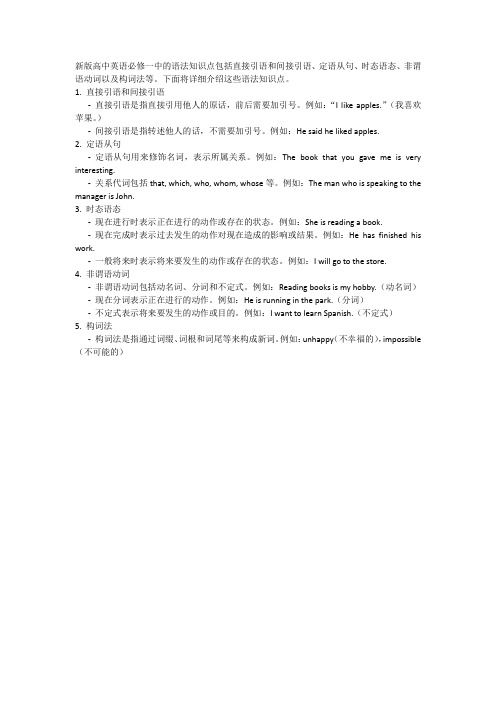
新版高中英语必修一中的语法知识点包括直接引语和间接引语、定语从句、时态语态、非谓语动词以及构词法等。
下面将详细介绍这些语法知识点。
1. 直接引语和间接引语-直接引语是指直接引用他人的原话,前后需要加引号。
例如:“I like apples.”(我喜欢苹果。
)-间接引语是指转述他人的话,不需要加引号。
例如:He said he liked apples.2. 定语从句-定语从句用来修饰名词,表示所属关系。
例如:The book that you gave me is very interesting.-关系代词包括that, which, who, whom, whose等。
例如:The man who is speaking to the manager is John.3. 时态语态-现在进行时表示正在进行的动作或存在的状态。
例如:She is reading a book.-现在完成时表示过去发生的动作对现在造成的影响或结果。
例如:He has finished his work.-一般将来时表示将来要发生的动作或存在的状态。
例如:I will go to the store.4. 非谓语动词-非谓语动词包括动名词、分词和不定式。
例如:Reading books is my hobby.(动名词)-现在分词表示正在进行的动作。
例如:He is running in the park.(分词)-不定式表示将来要发生的动作或目的。
例如:I want to learn Spanish.(不定式)5. 构词法-构词法是指通过词缀、词根和词尾等来构成新词。
例如:unhappy(不幸福的),impossible (不可能的)。
高中必修一英语语法整理总结
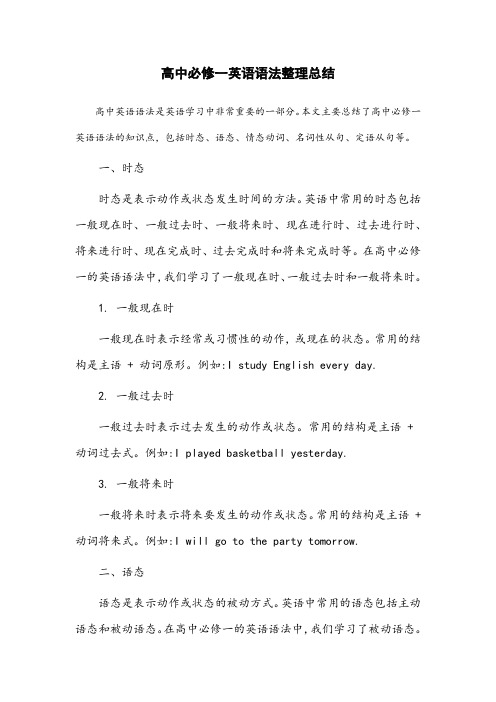
高中必修一英语语法整理总结高中英语语法是英语学习中非常重要的一部分。
本文主要总结了高中必修一英语语法的知识点,包括时态、语态、情态动词、名词性从句、定语从句等。
一、时态时态是表示动作或状态发生时间的方法。
英语中常用的时态包括一般现在时、一般过去时、一般将来时、现在进行时、过去进行时、将来进行时、现在完成时、过去完成时和将来完成时等。
在高中必修一的英语语法中,我们学习了一般现在时、一般过去时和一般将来时。
1. 一般现在时一般现在时表示经常或习惯性的动作,或现在的状态。
常用的结构是主语 + 动词原形。
例如:I study English every day.2. 一般过去时一般过去时表示过去发生的动作或状态。
常用的结构是主语 + 动词过去式。
例如:I played basketball yesterday.3. 一般将来时一般将来时表示将来要发生的动作或状态。
常用的结构是主语 + 动词将来式。
例如:I will go to the party tomorrow.二、语态语态是表示动作或状态的被动方式。
英语中常用的语态包括主动语态和被动语态。
在高中必修一的英语语法中,我们学习了被动语态。
1. 被动语态被动语态表示主语是动作的承受者。
常用的结构是 be + 过去分词。
例如:The book was read by the teacher.三、情态动词情态动词是表示能力、可能性或义务的动词。
英语中常用的情态动词包括 can、may、must、should、will 等。
在高中必修一的英语语法中,我们学习了情态动词的用法和意义。
1. cancan 表示能力或允许。
例如:I can speak English.2. maymay 表示可能性或允许。
例如:You may come to my party.3. mustmust 表示肯定或义务。
例如:He must study hard.4. shouldshould 表示应该或义务。
高中英语必修一第一章语法

高中英语必修一第一章语法1. 语法知识概述高中英语必修一第一章是关于语法的基础知识。
语法是语言的骨架,它规定了单词如何组织成句子,以及句子如何组织成段落和篇章。
掌握语法对于研究英语是至关重要的,它可以帮助我们正确地表达思想,避免语义歧义,使我们的语言更加流畅和准确。
2. 句子成分句子是语言的基本单位,了解句子的构成和成分对于理解和使用语法至关重要。
在英语语法中,一个句子通常由主语、谓语和宾语组成。
主语是句子的主要主题,谓语说明主语的动作或状态,宾语是受到动作影响的对象。
例如,"Tom is reading a book" (汤姆正在看书)是一个简单的英语句子。
其中,"Tom"是主语,"is reading"是谓语,"a book"是宾语。
3. 时态和语态时态和语态是英语语法中两个重要的方面。
时态表示动作或状态的时间,主要分为过去、现在和将来三种。
时态的正确使用可以使句子的意思更加清晰和准确。
语态表示动作的主动与被动,可以通过改变动词形式来实现。
被动语态在英语中应用广泛,使用被动语态可以使句子结构更加紧凑,同时也可以强调动作的承受者。
例如,"He has written a letter." (他写了一封信)是一个现在完成时的句子,表示动作发生在过去但与现在有关。
另外,"The book is being read by him." (这本书正在被他阅读)是一个被动语态的句子,强调动作的承受者。
4. 关系从句关系从句是一种修饰句子的从句,它可以提供额外的信息,进一步描述主句中的名词或代词。
关系从句通常由关系代词或关系副词引导。
关系代词有 "who", "whom", "whose", "which" 和 "that";关系副词有 "when", "where" 和 "why"。
高中英语新人教版必修一全册语法汇总(分单元编排)
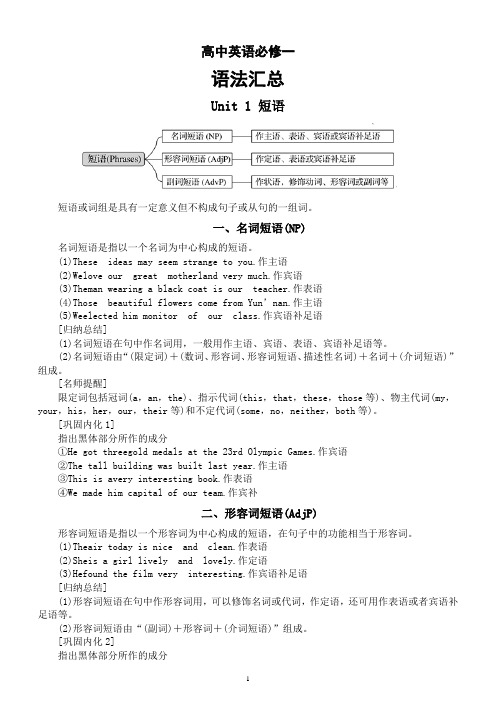
高中英语必修一语法汇总Unit 1 短语短语或词组是具有一定意义但不构成句子或从句的一组词。
一、名词短语(NP)名词短语是指以一个名词为中心构成的短语。
(1)These ideas may seem strange to you.作主语(2)Welove our great motherland very much.作宾语(3)Theman wearing a black coat is our teacher.作表语(4)Those beautiful flowers come from Yun’nan.作主语(5)Weelected him monitor of our class.作宾语补足语[归纳总结](1)名词短语在句中作名词用,一般用作主语、宾语、表语、宾语补足语等。
(2)名词短语由“(限定词)+(数词、形容词、形容词短语、描述性名词)+名词+(介词短语)”组成。
[名师提醒]限定词包括冠词(a,an,the)、指示代词(this,that,these,those等)、物主代词(my,your,his,her,our,their等)和不定代词(some,no,neither,both等)。
[巩固内化1]指出黑体部分所作的成分①He got threegold medals at the 23rd Olympic Games.作宾语②The tall building was built last year.作主语③This is avery interesting book.作表语④We made him capital of our team.作宾补二、形容词短语(AdjP)形容词短语是指以一个形容词为中心构成的短语,在句子中的功能相当于形容词。
(1)Theair today is nice and clean.作表语(2)Sheis a girl lively and lovely.作定语(3)Hefound the film very interesting.作宾语补足语[归纳总结](1)形容词短语在句中作形容词用,可以修饰名词或代词,作定语,还可用作表语或者宾语补足语等。
必修一英语必背语法知识点

必修一英语必背语法知识点(经典版)编制人:__________________审核人:__________________审批人:__________________编制单位:__________________编制时间:____年____月____日序言下载提示:该文档是本店铺精心编制而成的,希望大家下载后,能够帮助大家解决实际问题。
文档下载后可定制修改,请根据实际需要进行调整和使用,谢谢!并且,本店铺为大家提供各种类型的经典范文,如演讲致辞、规章制度、策划方案、合同协议、条据文书、心得体会、职业规划、教学资料、作文大全、其他范文等等,想了解不同范文格式和写法,敬请关注!Download tips: This document is carefully compiled by this editor. I hope that after you download it, it can help you solve practical problems. The document can be customized and modified after downloading, please adjust and use it according to actual needs, thank you!Moreover, our store provides various types of classic sample essays for everyone, such as speeches, rules and regulations, planning plans, contract agreements, documentary evidence, insights, career planning, teaching materials, complete essays, and other sample essays. If you want to learn about different sample formats and writing methods, please pay attention!必修一英语必背语法知识点必修一英语必背语法知识点_英语语法知识点英语语法是针对英语语言进行研究后,系统地总结归纳出来的一系列语言规则。
(完整版)高一英语必修一语法知识点总结

(完整版)高一英语必修一语法知识点总结高一英语必修一语法知识点总结1. 时态- 过去时:表示过去发生的动作或状态。
例如:He played football yesterday.(他昨天踢了足球。
)- 现在时:表示现在正在进行或经常发生的动作。
例如:She is reading a book.(她正在读一本书。
)- 将来时:表示将来要发生的动作或状态。
例如:I will go to the park tomorrow.(明天我将去公园。
)2. 名词- 单数名词:表示一个人、物或概念。
例如:book(书)- 复数名词:表示多个人、物或概念。
例如:books(书)- 不可数名词:表示抽象概念或一类事物。
例如:information(信息)3. 代词- 主格代词:在句子中做主语。
例如:I(我)- 宾格代词:在句子中做宾语。
例如:him(他)- 形容词性物主代词:用来表示所属关系。
例如:my(我的)4. 形容词- 描述名词的特征或性质。
例如:beautiful(美丽的)5. 副词- 描述动词、形容词、副词或全句的特征。
例如:quickly(快速地)6. 动词- 表达动作、状态或存在。
例如:run(跑)7. 介词- 表示位置、方向、时间、原因等关系。
例如:in(在)8. 连词- 连接词语、短语、从句等。
例如:and(和)以上是高一英语必修一中的一些重要的语法知识点总结。
(注意:文档内容仅供参考,请勿引用未经确认的内容。
)。
高中必修一英语语法

考点1:现在进行时表示将来位移动词的进行时表示将来现在进行时表示将来主要用于表示按计划或安排将要进行的动作,常有"意图;安排;打算"的含义。
这种用法通常要带一个表示将来的时间状语。
有此用法的动词多是位移动词,如arrive, come, get, go, leave, return, start, take off, fly等。
▶They are coming here this afternoon. 他们今天下午要来这儿。
▶She is leaving tomorrow and you had better see her off. 她明天要离开了,你最好去送送她。
▶When are you starting off? 你什么时候动身?非位移动词的进行时表示将来现在进行时表示将来除使用位移动词外,也可使用某些非位移动词,如do, buy, meet, have, play, publish等,此时句中一般要有表示将来的时间状语。
▶The young man is meeting his girlfriend this afternoon. 这个年轻人今天下午要去见他的女朋友。
▶I am publishing a book this year. 我打算今年出一本书。
▶What are you doing next Sunday? 下周日你打算干什么?▶She is buying a new bike soon. 不久她将买一辆新自行车。
考点2:将来时的其他表达法1:will/shall dowill/shall do表达单纯的将来时,是对未来事情发生的一种“预见性”。
可用于说话时才想到或决定的事。
will可用于各种人称,而shall多用于第一人称。
▶This time next week I will/shall be in Scotland. 下周这个时候我就在苏格兰了。
▶My brother will leave for the United States next week. 我的哥哥下星期要到美国去。
英语必修一语法知识点
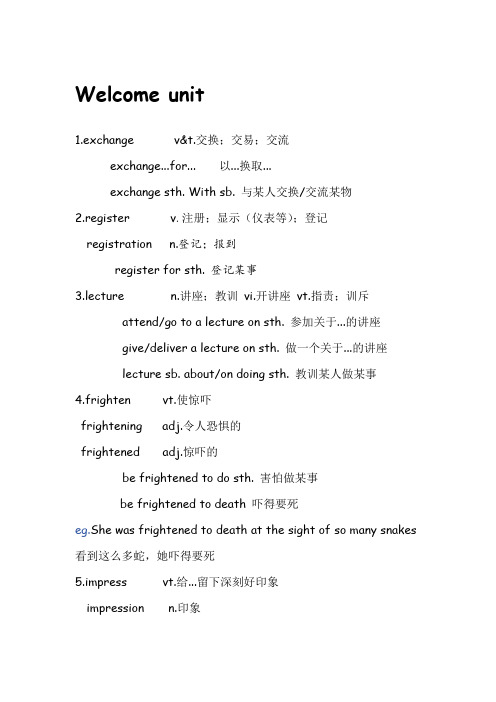
Welcome unit1.exchange v&t.交换;交易;交流exchange...for... 以...换取...exchange sth. With sb. 与某人交换/交流某物2.register v.注册;显示(仪表等);登记registration n.登记;报到register for sth. 登记某事3.lecture n.讲座;教训vi.开讲座vt.指责;训斥attend/go to a lecture on sth. 参加关于...的讲座give/deliver a lecture on sth. 做一个关于...的讲座lecture sb. about/on doing sth. 教训某人做某事4.frighten vt.使惊吓frightening adj.令人恐惧的frightened adj.惊吓的be frightened to do sth. 害怕做某事be frightened to death 吓得要死eg.She was frightened to death at the sight of so many snakes 看到这么多蛇,她吓得要死5.impress vt.给...留下深刻好印象impression n.印象impressive adj.令人印象深刻的impress sth. on/upon sb. 使某人意识到leave a(n) ...impression on sb. 给某人留下...印象be impressed with/by 对...印象深刻6.concentrate vi.&vt. 集中(注意力);浓缩concentration n.专心concentrate one’s attention on 集中注意力于with (great) concentration 聚精会神地7.curious adj.好奇的;求知欲强的curiousity n.好奇心curiously adv.好奇地be curious about 对...好奇be curious to do sth. 很想做某事out of curiousity 出于好奇Unit 11.volunteer n.志愿者v.自愿voluntary adj. 自愿的voluntarily adv.自动的volunteer to do sth. 自愿做某事volunteer as sth. 自愿担任某职位volunteer for sth. 自动提出某事2.debate n.争论v.辩论under debate 在讨论中debate with sb. about/on sth. = debate sth. with sb.就...与某人辩论3.prefer vt.较喜欢preference n.偏爱prefer (sb.) to do sth. 宁愿(某人)做某事prefer (doing) A to (doing) B 比起B,更喜欢A=prefer to do...rather than do 宁愿做...而不愿做have a preference for 偏爱...4.content n.内容adj.满足的v.使满足contents n.目录;所含之物be content to do 满足于做某事be/feel content with 对...满意content oneself (with) 对...感到满意to one’s content 心满意足地5.confuse vt.使糊涂;使迷惑confused adj.感到困惑的confusing adj.令人困惑的confusion n.困惑confuse A with/and B 把A与B混淆be/get confused about 对...感到困惑6.fluent adj.流利的fluently adv.流利的fluency n.流利be fluent in 熟练的7.graduate v.毕业n.毕业生graduation n.毕业典礼graduate from 毕业于...(学校)graduate in 毕业于...(专业)8.attract vt.吸引attractive adj.有吸引力的attraction n.吸引力be attracted to 喜爱attract sb. to 把某人吸引到...attract one’s attention (to) 引起某人的注意have no/much attraction for 对...没有/很有吸引力a tourist attraction 旅游景点9.generation n.一代人from generation to generation 一代又一代generation gap 代沟10.focus vi.&vt.集中(精力、注意力);调节焦距n.中心focused adj.注意力集中的;目标明确的focus on 集中focus one’s eyes on 注视focus one’s attention on 集中注意力于... 11.addicted adj.有瘾的;入迷的addict n.对...入迷的人addictive adj.使人上瘾的addiction n.入迷be addicted to 对...很入迷12.recommend vt.建议;推荐recommend sb. to do sth. 建议某人做某事recommend sth. to sb. 向某人推荐某物recommend sb. for sth. 推荐/介绍某人#recommend接从句,用虚拟语气”(should)+动词原形”13.schedule n.日程安排vt.安排;预定be scheduled to do sth. 计划做某事be scheduled for 定于...14.expert n.专家adj.熟练的an expert in... 在...方面的专家be expert at/in (doing) sth. 在...方面熟练Unit 21.apply vi.&vt.申请vt.应用;涂(油漆、乳剂)application n.申请applicant n.申请者apply to do sth. 申请做某事apply oneself to (doing) sth. 致力于(做)某事apply to sb. for sth. 向某人申请某事apply A to B 把A应用于B/把A涂在B2.rent n.租金;撕裂v.出租、租用rent sth. from sb. 从某人那里租用某物rent sb. sth.=rent sth (out) to sb. 把某物租给某人for rent 出租pay the rent 付租金3.pack vi.&vt.包装、打包;收拾n.群;纸盒unpack n.打开packed adj.挤满人的;收拾好行李的pack off 运走pack up 收拾行李pack away 解雇;打包扔掉;收藏a pack of 一群4.amaze vt.使惊奇;使惊讶amazed adj.惊奇的amazement n.惊奇amazingly adv.令人惊讶地be amazed at/by/that... 对...感到惊奇be amazed to do 对做某事感到惊奇to one’s amazement 使某人惊奇的是in amazement 惊讶地5.arrange v.安排arrangement n.安排arrange for 安排;准备arrange for sb. to do sth. 安排某人做某事arrange with sb. about sth. 与某人商定某事make arrangements for sth. 为...做安排6.extreme n.极端;极限adj.极度的extremely adv.极其go to extrements 走极端7.narrow adj.狭窄v.使窄小n.峡谷narrowly adv.仔细地narrow the gap 缩小代沟narrow escape death 死里逃生a narrow escape 九死一生8.power n.权力;力量v.推动;快速前进powerless adj.无力的in the power of 在...的控制下come into power 掌权;上台执政9.control n.控制权;限制v.控制;指挥take control of 控制;掌管beyond/outside sb’s control 无法控制out of control 不受控制be under control 受控制,被控制keep sth. under control 使某事受控制10.office n.办公室official n.官员adj.公务的officer n.军官officially adv.官方地;正式地11.recognise v.承认、认出recognition n.认出、认识recognise sb./sth. as/to be 承认...是...recognise sb. by sth. 根据某物认出某人It’s recognised that 人们公认...beyond recognition 辨认不出12.accommodation n.住所accommodate v.向...提供住所provide accommodation for 为...提供膳宿13.admire vt.欣赏;倾佩admiration n.钦佩admirable adj.令人钦佩的admire sb. for sth. 因某事钦佩某人have admiration for sb./sth. 钦佩某人/某事14.contact n.接触;联系be in/out of contact with 与...有/失去联系keep in contact with 与...保持联系lose contact with 和...失去联系make contact with 与...来往eye contact 眼神交流15.make up 编造;化妆;构成;弥补+forbe made up of 由...组成16.credit n.信誉;学分creditable adj.值得赞扬的be a credit to sb./sth. 是...的骄傲to one’s credit ...值得赞扬的事17.request n.请求v.要求at one’s request = at the request of sb. 应某人的要求make a request for 要求/请求...request sb. to do sth. 要求某人做某事request that sb. (should) do sth. 要求某人18.强调句型:It is/was +被强调部分+that/who+其他部分#当强调的是由until引导的短语或从句:It is/was not until...that+其他部分19.other than 除...以外#多用于否定,含义比较接近except/butrather than 而不是more than 多于Unit 31. alone 跟随;到达;进步;赶快about 产生;发生across 偶然遇见come out 出现;出版up 走近;上升up with 提出;想出to 总计;到达2.honour n.荣誉;荣幸;尊敬It’s great honour to do sth.=be/feel honoured to do sth. 做某事感到荣幸in honour of 为了纪念honour sb. with sth. 授予某人某种荣誉3.determination n.决心;决定determine v.决定;确定determined adj.坚决的;坚定的determine to do sth. 决定做某事determine on/upon sth. 决定某事be determined to do sth. 决心做某事4.injure vt.使受伤;损害injury n.伤害;损伤injured adj.受伤的;受损的the injured 伤员5.strength n.力量;体力;优点strong adj.强壮的strengthen v.加强;增强build up one’s strength 增强体力have the strength to do sth. 有做某事的力气strengths and weaknesses 强项和弱项6.failure n.失败;失败的人(事)fail v.失败;不及格heart failure 心脏衰竭end in failure 以失败告终fail to do sth. 未能做成某事eg.failure is the mother of success 失败是成功之母7. up 放弃;投降in(to sb.) (向某人)屈服;让步away 赠送;泄露give off 散发(光、热、气味)out 分发;宣布;耗尽back 归还;使恢复way to 让路pete vi.竞争;对抗;参加比赛competitor n.对手;竞争者competition n.竞争;比赛competitive adj.有竞争力的compete in 参加...比赛compete with/against 与...竞争compete for 为...竞争compete to do sth. 竞争做某事9.pretend v.假装;装扮pretend to be... 假装是...pretend to do sth. 假装做某事pretend to be doing sth. 假装正在做某事pretend to have done sth. 假装做过某事10.fitness n.健康fit adj.健康的,适合的keep/stay fit 保持健康be fit for sth. 适合/胜任be fit to do sth. 适合/胜任做某事11.event n.比赛项目;大事eventful adj.多事的an eventful year 多事之秋12.make it 获得成功;准时到达make it to... 准时到达...make use of=take advantage of 利用make one’s way (to)去/前往13.set an example 树立榜样set an example to/for sb. 为某人树立榜样follow one’s example 以某人为榜样take...for example = take...as an examle 以...为例14.lose heart 丧失信心lose one’s heart to 倾心于...lose one’s temper 发脾气lose one’s way 迷路lose oneself in = put one’s heart into 全神贯注于heart and soul 全心全意learn...by heart 记住;牢记15. out 停止做;剪下;切去;删除off 切断;中断;使隔绝cut up 切碎in 插嘴;超车down (on) 砍倒;消减aross 穿过(某地)[尤指抄近路]pare v.比较;把...比作comparison n.比较compare with/to ...相比较/比作by comparison 相比之下in/by cmparison with 与...相比Unit 41.rescue n.&vt.营救;救援come to one’s rescue 营救某人rescue...from 把...从...解救出来2.damage vt.破坏n.损坏be badly damaged 严重受损do/cause damage to 给...带来损坏3.death n.死亡dead adj.死的dying adj.临死的deadly adj.致命的adv.极其frighten/scare sb. to death 把某人吓得要死die(dying,died,died)v.死亡;消失die of/from 因...而死die out 灭绝die away 逐渐减弱4.flood n.洪水be flooded with 被...淹没flood in/into 大量涌入a flood of/floods of 大量5.affect v.影响effect n.影响affection n.感情;喜爱be deeply affected by 被...深深打动have an affect on/upon 对...有影响come into effect 生效;开始实施take effect 生效;开始起作用6.shelter n.避难所;庇护v.保护;躲避under the shelter of 在...庇护下shelter from 躲避shelter/protect...from 保护...免受7.shock n.&v.震惊in shock 震惊的It’s shocking that =to one’s shock 令某人吃惊的是be shocked at/by 对...吃惊8.trap n.陷阱v.陷入圈套be trapped/stuck in 被困在...里trap sb. into doing sth. 诱使某人做某事set a trap for 给...设圈套fall/walk into a trap 落入陷阱9.bury v.埋葬;安葬bury one’s face/head in one’s hands 双手捂脸/抱头bury oneself in doing sth.=be buried in doing sth.埋头于/专心于10.breath. v.呼吸breath n.呼吸out of breath 气喘吁吁hold one’s breath 屏住呼吸breath deeply=take a deep breath 深呼吸take one’s breath away 令人惊叹11.effort n.努力effortless adj.不费力的make efforts/an effort to do sth.努力/尽力做某事spare no effort to do sth. 不遗余力做某事without effort 毫不费力with joint effort 共同努力in an effort to do sth.为了做成某事12.suffer v.遭受suffering n.痛苦;苦难sufferer n.受难者suffer +n.(抽象的损害)suffer from+n. (具体的不幸、痛苦)13.supply n.供应supply sb.with sth.=supply sth. to sb.给某人提供某物#provide sb. with sth.=provide sth. for sb.offer sb. sth.=offer sth.to sb.14.survive v.生存survival n.生存survivor n.幸存者survive on...=live on... 以...存活survive sb. by... 比某人多活...15.calm adj.镇静的v.使镇静keep/stay/remain calm 保持镇静calm...down 使...平静下来16.aid n.&v.援助;帮助with the aid/help of 在...帮助下aid/help sb. with sth. 帮助某人某事aid sb. to do sth. =aid sb. in doing sth.=aid sb. with sth.帮助某人做某事come to one’s aid 帮助某人in aid of 为了帮助17. 在手头in in 上交现有on out 分发在手边at help on 留给手工by over 交出18.up 打扫away 消灭sweep over/back 突然袭击aside 不理会19.strike v.击打be/go on strike 罢工be stuck on/with/by 被...深深打动/迷住It strikes sb. that 某人突然想起20.deliver v.递送delivery n.递送deliver/address/give a speech 发表演讲deliver sth. to sb. 把某物运送给某人Unit 51.native adj.本地的n. 本地人be native to sp. 原产于# ①sp. be home to ...是...的原产地②be unique to ...是...所持有的2.attitude n.态度;看法show/hold/keep/develop/have an/a ... attitude to/towords 对...的态度3.refer v.提到;参考;查询(refer-referring-referred)reference n.参考refer to...as... 把... 当作/称为4.base v. 以...为基础n.底部;根据based adj.以...为基础basic adj.基本的basically adv.基本上basis n.基础;准则on the basis of 基于base sth. on/upon sth. =be based on/upon sth. 以...为根据be based on... 以...为基础5.variety n.(语言,植物)变体;异体;多样化the variety of ...种类a variety of /varieties of 各种各样的various adj.各种各样的vary v.变化;改变①vary with 随着...变化②vary in 在...方面不同/有差异③vary between 在两者之间变化④vary from...to... 从...到...不等6.major adj.主要的v.主修majority n. 大多数major in 主修play a major role/part in 在...中扮演重要的角色the majority of 大多数的be in/a majority 占多数的7.means n.方式by means of 以...方式by this means = in this way = with this method 用这种方式by no means 绝不by all means 可以;没问题mean v.意味;想要8.regard n.尊重v.把...视为regard ... as =...be regarded as 把...视为... regarding perp.=about/concerning =with/in regard to 至于;关于9.appreciate v.欣赏;感激appreciat +n./pron./v-ing/one’s doing sth.感激某人做了某事I wound appreciate it if...假如...,我将不胜感激#appreciate,hate,dislike,love,like,depend/reply on等接宾语从句时,一般先加it,再接宾语appreciation n.欣赏;感激show/express one’s appreciation to sb. for sth.表达对某人感激之情appreciative adj.令人感激的be appreciative of = be grateful sb. for sth. 对...感激10.specific adj.特定的;明确的specifically adv.特定的specific to 特定于;针对to be specific 具体来说11.struggle n.&v. 斗争;搏斗struggle/fight for 为...而斗争struggle with/against ... 与...作斗争struggle to do sth. 努力做某事struggle to one’s feet 挣扎着站起来12.equal adj.相同的n. 相等的人equally adv.相等地equality n.平等unequal adj.不相等be equal to = be up to =be fit与...相等;能胜任without equal=beyond comparison 无与伦比13.demand n.需求v.强烈需求demanding adj.要求高的meet/satisfy one’s demands/needs 满足某人的需求be in (great)demand = be in need 有很大需求demand of sb. to do sth.要求做某事demand +that (虚拟语气,should+v.原)14.description n.描写describe vt.描述descriptive adj.描述的beyond description 难以形容的15.relate v.联系relation n.关系unrelated adj.不相关的related adj.相关的relate...to...= be related to 与...有关relatively speaking 相对来说。
高一英语必修一句型
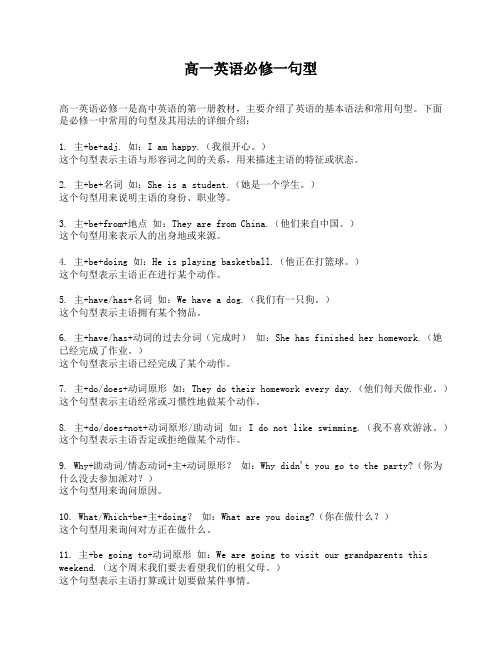
高一英语必修一句型高一英语必修一是高中英语的第一册教材,主要介绍了英语的基本语法和常用句型。
下面是必修一中常用的句型及其用法的详细介绍:1. 主+be+adj. 如:I am happy.(我很开心。
)这个句型表示主语与形容词之间的关系,用来描述主语的特征或状态。
2. 主+be+名词如:She is a student.(她是一个学生。
)这个句型用来说明主语的身份、职业等。
3. 主+be+from+地点如:They are from China.(他们来自中国。
)这个句型用来表示人的出身地或来源。
4. 主+be+doing 如:He is playing basketball.(他正在打篮球。
)这个句型表示主语正在进行某个动作。
5. 主+have/has+名词如:We have a dog.(我们有一只狗。
)这个句型表示主语拥有某个物品。
6. 主+have/has+动词的过去分词(完成时)如:She has finished her homework.(她已经完成了作业。
)这个句型表示主语已经完成了某个动作。
7. 主+do/does+动词原形如:They do their homework every day.(他们每天做作业。
)这个句型表示主语经常或习惯性地做某个动作。
8. 主+do/does+not+动词原形/助动词如:I do not like swimming.(我不喜欢游泳。
)这个句型表示主语否定或拒绝做某个动作。
9. Why+助动词/情态动词+主+动词原形?如:Why didn't you go to the party?(你为什么没去参加派对?)这个句型用来询问原因。
10. What/Which+be+主+doing?如:What are you doing?(你在做什么?)这个句型用来询问对方正在做什么。
11. 主+be going to+动词原形如:We are going to visit our grandparents this weekend.(这个周末我们要去看望我们的祖父母。
英语高一必修一语法词汇句型大总结
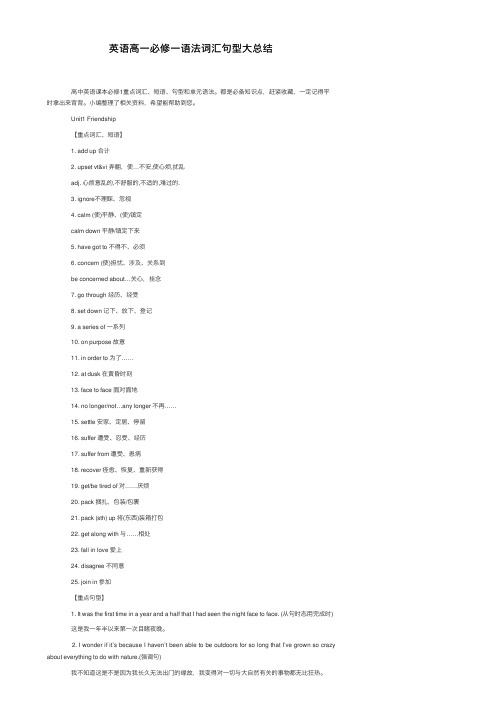
英语⾼⼀必修⼀语法词汇句型⼤总结 ⾼中英语课本必修1重点词汇、短语、句型和单元语法。
都是必备知识点,赶紧收藏,⼀定记得平时拿出来背背。
⼩编整理了相关资料,希望能帮助到您。
Unit1 Friendship 【重点词汇、短语】 1. add up 合计 2. upset vt&vi 弄翻,使…不安,使⼼烦,扰乱 adj. ⼼烦意乱的,不舒服的,不适的,难过的. 3. ignore不理睬、忽视 4. calm (使)平静、(使)镇定 calm down 平静/镇定下来 5. have got to 不得不、必须 6. concern (使)担忧、涉及、关系到 be concerned about…关⼼,挂念 7. go through 经历、经受 8. set down 记下、放下、登记 9. a series of ⼀系列 10. on purpose 故意 11. in order to 为了…… 12. at dusk 在黄昏时刻 13. face to face ⾯对⾯地 14. no longer/not…any longer 不再…… 15. settle 安家、定居、停留 16. suffer 遭受、忍受、经历 17. suffer from 遭受、患病 18. recover 痊愈、恢复、重新获得 19. get/be tired of 对……厌烦 20. pack 捆扎,包装/包裹 21. pack (sth) up 将(东西)装箱打包 22. get along with 与……相处 23. fall in love 爱上 24. disagree 不同意 25. join in 参加 【重点句型】 1. It was the first time in a year and a half that I had seen the night face to face. (从句时态⽤完成时) 这是我⼀年半以来第⼀次⽬睹夜晚。
高一英语 必修一语法归纳
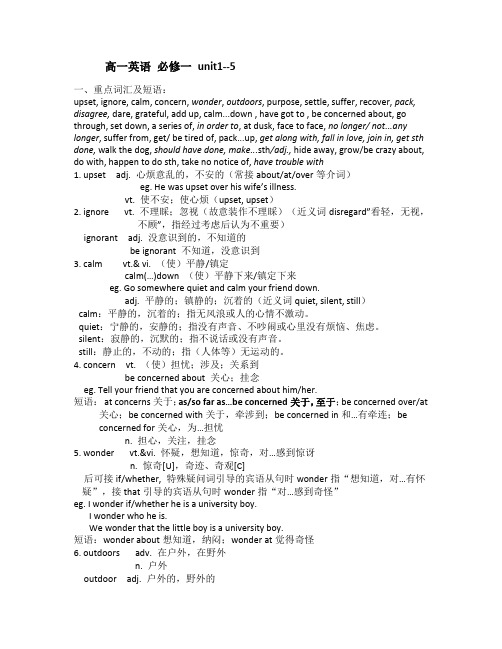
高一英语必修一unit1--5一、重点词汇及短语:upset, ignore, calm, concern, wonder, outdoors, purpose, settle, suffer, recover, pack, disagree, dare, grateful, add up, calm...down , have got to , be concerned about, go through, set down, a series of, in order to, at dusk, face to face, no longer/ not...any longer, suffer from, get/ be tired of, pack...up, get along with, fall in love, join in, get sth done, walk the dog, should have done, make...sth/adj., hide away, grow/be crazy about, do with, happen to do sth, take no notice of, have trouble with1. upset adj. 心烦意乱的,不安的(常接about/at/over等介词)eg. He was upset over his wife’s illness.vt. 使不安;使心烦(upset, upset)2. ignore vt. 不理睬;忽视(故意装作不理睬)(近义词disregard”看轻,无视,不顾”,指经过考虑后认为不重要)ignorant adj. 没意识到的,不知道的be ignorant 不知道,没意识到3. calm vt.& vi. (使)平静/镇定至于;be concerned over/at和…有牵连;be concerned 5. wonder vt.&vi. 怀疑,想知道,惊奇,对…感到惊讶n. 惊奇[U],奇迹、奇观[C]后可接if/whether, 特殊疑问词引导的宾语从句时wonder指“想知道,对…有怀疑”,接that引导的宾语从句时wonder指“对…感到奇怪”eg. I wonder if/whether he is a university boy.I wonder who he is.We wonder that the little boy is a university boy.短语:wonder about想知道,纳闷;wonder at觉得奇怪6. outdoors adv. 在户外,在野外n. 户外outdoor adj. 户外的,野外的7. purpose n. 目的,计划,意图,目标短语:on purpose故意;with the purpose of…带有…的目的;for the purpose of…为了…的目的eg. Don’t hurt your best friend on purpose.8. settle vi. 安家,定居,停留vt. 使定居,安排,解决,使沉淀,使平静settle down 定居,专心于,安定下来settle in 迁入settled adj. 固定的,稳定的settler n[C]. 移民者,殖民者settlement n[C]. 定居点,住宅区;n[U]沉降,解决9. suffer vt. 遭受,忍受,经历vi. 受…之苦,折磨suffer from 遭受,患病eg. Mary is suffering from the sadness of her blindness.近义词:undergo v. 经历,遭受10. recover vt.& vi. 痊愈,恢复,重新获得/近义词:restore 恢复(强调外力使得恢复)eg. Jennie made a great effort to recover herself.dare to do sth./dare do sth.)eg. I dare say it will rain today.14. grateful adj. 感激的,表示谢意的be grateful to/towards对…表示感激;be grateful for为…表示感激be grateful to…for…为...而对…表示感激eg. I’ll be very gratef ul to you if you give me an early answer.I’m very grateful for all that you’ve done to us.I’m very grateful to you for having helped me so much.15. add up 合计add v. 添加,增加(近义词:increase),将…相加,补充说add A to B 在B中加入Aadd up to 合起来为add to增加,增添(多指抽象意义)add…in…把…加进去,包括16. have got to 不得不,必须(近义词:have to)两者的区别:1. have got to的否定形式是haven’t got to, 疑问句形式have提前;have to的否定形式和疑问句形式是借助助动词do/does/did;2. have got to不和will,情态动词连用,have to可以。
高一必修一英语语法

1.able 用法:be able to doNote: 反義詞unable表示不能,而disabled表示殘疾的。
be able to do可以表示經過艱難困苦才能做到的事。
2.abroad 用法:表示到(在)國外,是一個副詞,前面不加介詞。
Note: 可以說from abroad, 表示從國外回來。
3.admit 用法:表示承認的時候後面要加上動名詞形式。
Note: 表示允許進入的時候與介詞to搭配。
4.advise 用法:advise sb. to do; advise doingNote: 后面的宾语从句要用虚拟语气。
即:advise that sb. (should) do的形式。
5.afford 用法:通常与动词不定式搭配使用。
Note: 前面需要有be able to或can等词。
6.after 用法:表示在时间、空间之后;be after表示追寻。
Note: 用在将来时的时候后面接一时间点,而in接一个时间段,如:after 3 o’clock; in 3 days.7.agree 用法:与介词on, to, with及动词不定式搭配。
Note: agree on表示达成一致;agree to表示批准;agree with表示同意某人说的话。
8.alive 用法:表语性形容词,在句中只能作表语,不能作定语。
Note: 可以作状语使用,表示活活地,如:bury sb. alive.9.allow 用法:allow doing; allow sb. to doNote: 可以表示允许进入,如:Please allow me in.10.among 用法:用在三者或三者以上的群体中。
Note: 还可以表示其中之一,如:He is among the best.11.and 用法:用于连接两个词、短语、句子或其他相同结构。
Note: 与祈使句搭配时往往可以表示条件。
如:Work hard, and you’ll succeed sooner or later.12.another 用法:表示又一个,泛指,相当于one more的含义。
- 1、下载文档前请自行甄别文档内容的完整性,平台不提供额外的编辑、内容补充、找答案等附加服务。
- 2、"仅部分预览"的文档,不可在线预览部分如存在完整性等问题,可反馈申请退款(可完整预览的文档不适用该条件!)。
- 3、如文档侵犯您的权益,请联系客服反馈,我们会尽快为您处理(人工客服工作时间:9:00-18:30)。
高中必修一英语语法一般现在时的用法1) 经常性或习惯性的动作,常与表示频腮度的时间状语连用。
时间状语:every…, sometimes, at…, on Sunday。
例如:I leave home for school at 7 every morning. 每天早上我七点离开家。
2) 客观真理,客观存在,科学事实。
例如:The earth moves around the sun. 地球绕太阳转动。
Shanghai lies in the east of China. 上海位于中国东部。
3) 表示格言或警句。
例如:Pride goes before a fall. 骄者必败。
注意:此用法如果出现在宾语从句中,即使主句是过去时,从句谓语也要用一般现在时。
例:Columbus proved that the earth is round. 哥伦布证实了地球是圆的。
4) 现在时刻的状态、能力、性格、个性。
例如:I don't want so much. 我不要那么多。
Ann writes good English but does not speak well. 安英语写得不错,讲的可不行。
比较:Now I put the sugar in the cup. 把糖放入杯子。
I am doing my homework now. 我正在做功课。
第一句用一般现在时,用于操作演示或指导说明的示范性动作,表示言行的瞬间动作。
第二句中的now是进行时的标志,表示正在进行的动作的客观状况,所以后句用一般现在时。
2 一般过去时的用法1)在确定的过去时间里所发生的动作或存在的状态。
例如:时间状语有:yesterday, last week, an hour ago, the other day, in 1982等。
例如:Where did you go just now? 刚才你上哪儿去了?2)表示在过去一段时间内,经常性或习惯性的动作。
例如:When I was a child, I often played football in the street. 我是个孩子的时候,常在马路上踢足球。
Whenever the Browns went during their visit, they were given a warm welcome. 那时,布朗一家无论什么时候去,都受到热烈欢迎。
3)句型:It is time for sb. to do sth "到……时间了" "该……了"。
例如:It is time for you to go to bed. 你该睡觉了。
It is time that sb. did sth. "时间已迟了" "早该……了" ,例如It is time you went to bed. 你早该睡觉了。
would (had) rather sb. did sth. 表示'宁愿某人做某事'。
例如:I'd rather you came tomorrow.还是明天来吧。
4) wish, wonder, think, hope 等用过去时,作试探性的询问、请求、建议等,而一般过去时表示的动作或状态都已成为过去,现已不复存在。
例如:I thought you might have some. 我以为你想要一些。
比较:Christine was an invalid all her life.(含义:她已不在人间。
) Christine has been aninvalid all her life.(含义:她现在还活着) Mrs. Darby lived in Kentucky for seven years. (含义:达比太太已不再住在肯塔基州。
) Mrs. Darby has lived in Kentucky for seven years. (含义:现在还住在肯塔基州,有可能指刚离去)注意:用过去时表示现在,表示委婉语气。
1)动词want, hope, wonder, think, intend 等。
例如:Did you want anything else? 您还要些什么吗? I wondered if you could help me. 能不能帮我一下。
2)情态动词could, would。
例如:Could you lend me your bike? 你的自行车,能借用一些吗?3 used to / be used to used to + do:"过去常常"表示过去习惯性的动作或状态,但如今已不存在。
例如:Mother used not to be so forgetful. 老妈过去没那么健忘。
Scarf used to take a walk. 斯卡夫过去常常散步。
be used to + doing:对……已感到习惯,或"习惯于",to是介词,后需加名词或动名词。
例如:He is used to a vegetarian diet. Scarf is used to taking a walk. 斯卡夫现在已习惯于散步了。
典型例题---- Your phone number again? I ___ quite catch it. ---- It's 69568442 A. didn't B. couldn't C. don't D. can't答案A. 本句虽没有明确的时间状语,但从语意上看出,在听的时候没有听懂这个动作发生在过去,因此应用过去时。
4 一般将来时1) shall用于第一人称,常被will 所代替。
will 在陈述句中用于各人称,在征求意见时常用于第二人称。
例如:Which paragraph shall I read first? 我先读哪一段呢? Will you be at home at seven this evening? 今晚七点回家好吗?2) be going to +不定式,表示将来。
a. 主语的意图,即将做某事。
例如:What are you going to do tomorrow? 明天打算作什么呢?b. 计划,安排要发生的事。
例如:The play is going to be produced next month。
这出戏下月开播。
c. 有迹象要发生的事。
例如:Look at the dark clouds, there is going to be a storm. 看那乌云,快要下雨了。
3) be +不定式表将来,按计划或正式安排将发生的事。
例如:We are to discuss the report next Saturday.我们下星期六讨论这份报告。
4) be about to +不定式,意为马上做某事。
例如:He is about to leave for Beijing. 他马上要去北京。
注意:be about to do 不能与tomorrow, next week 等表示明确将来时的时间状语连用。
5 be going to / will 用于条件句时,be going to表将来,will表意愿。
例如:If you are going to make a journey, you'd better get ready for it as soon as possible.Now if you will take off your clothes, we will fit the new clothes on you in front of the mirror.6 be to和be going to be to 表示客观安排或受人指示而做某事,be going to 表示主观的打算或计划。
例如:I am to play football tomorrow afternoon. 明天下午我去踢球。
(客观安排) I'm going to play football tomorrow afternoon. 明天下午我想去踢球。
(主观安排)7 一般现在时表将来1)下列动词come, go, arrive, leave, start, begin, return的一般现在时可以表示将来,主要用来表示在时间上已确定或安排好的事情。
例如:The train leaves at six tomorrow morning. 火车明天上午六点开。
When does the bus star? It stars in ten minutes. 汽车什么时候开?十分钟后。
2)以here, there等开始的倒装句,表示动作正在进行。
例如:Here comes the bus. = The bus is coming. 车来了。
There goes the bell. = The bell is ringing. 铃响了。
3)在时间或条件句中。
例如:When Bill comes (不是will come), ask him to wait for me. 比尔来后,让他等我。
I'll write to you as soon as I arrive there. 我到了那里,就写信给你。
4)在动词hope, take care that, make sure that等的宾语从句中。
例如:I hope they have a nice time next week. 我希望他们下星期玩得开心。
Make sure that the windows are closed before you leave the room. 离开房间前,务必把窗户关了。
返回动词的时态目录11.8 用现在进行时表示将来下列动词come, go, arrive, leave, start, begin, return等现在进行时可以表示将来。
例如:I'm leaving tomorrow. 明天我要走了。
Are you staying here till next week? 你会在这儿呆到下周吗? 返回动词的时态目录11.9 现在完成时现在完成时用来表示之前已发生或完成的动作或状态,其结果的影响现在还存在;也可表示持续到现在的动作或状态。
其构成:have (has) +过去分词。
1. Only after my friend came ____. (2005 福建)A. did the computer repairB. he repaired the computerC.was the computer repairedD. the computer was repaired【解析】选C本题考查的是由only引导的状语提到句首时,需要倒装。
